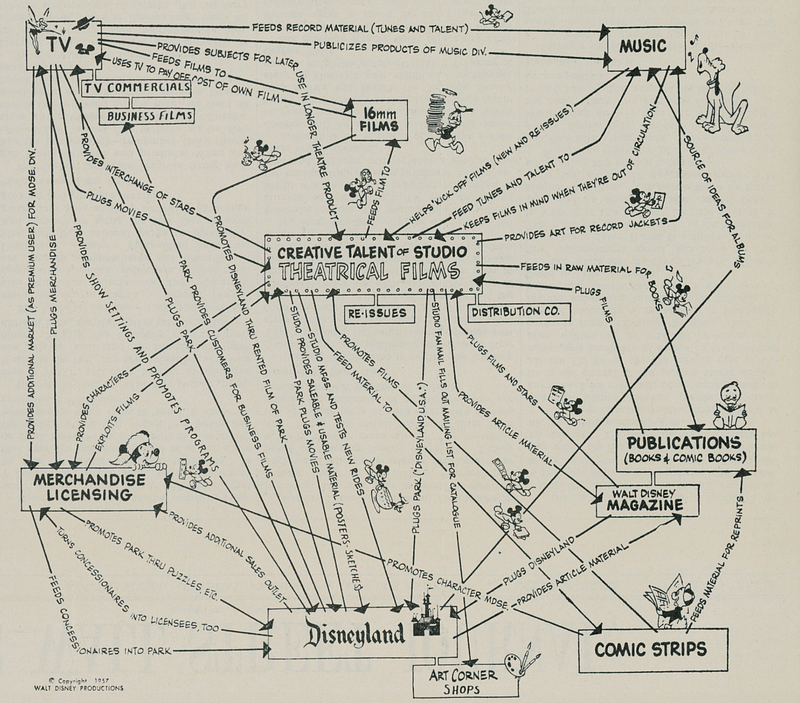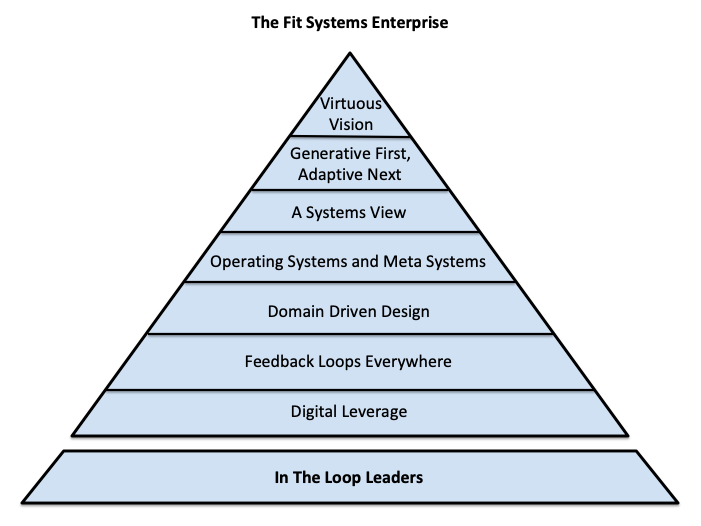Introduction
“You never change things by fighting existing reality. To change something, build a new model that makes the existing model obsolete.” — Buckminster Fuller (1895–1983)
The globe is connected, and software is eating it. Digital change is fast and accelerating. Technology is growing in its power, capable of being leveraged for good or ill. We have finally reached the point of no return: every company with aspirations for scale must be a digital technology company, grounded in a virtuous vision and pursuing fitness in all of its systems. In today’s world, winners will be separated from losers by their relative digital leverage. The effect of this new reality on enterprise leadership could not be more profound.
It’s time for a new paradigm of leadership. The new paradigm is fundamentally different than the old. It works from the premise that stability is impossible, predictability ephemeral, supply side optimization secondary, regeneration primary, and high velocity growth achievable.
In the face of dizzying change, the two core objectives of the new paradigm are to be generative and adaptive. The generative imperative is the first and most important priority. This is the imperative to generate new value. In a world of constant change and rising competitors, the half life of an enterprise’s product value is steadily shortening. You have to create new value just to stay even. That’s the generative imperative. The adaptive imperative is the second priority. This is the priority to make the enterprise more resilient, scalable and efficient. Digital leverage is key in achieving both.
Digital technology is driven by feedback loops. In a world of constant change, the feedback loop is the secret to success. This explains the new paradigm’s name: “the Loop Paradigm” (The Loop, for short).
A key attribute of “In the Loop” leadership is systems thinking. You can’t achieve agility and digital leverage without it. Systems are everywhere. A tree is a system. The Boston Symphony Orchestra’s playing of Beethoven’s Fifth is a system. A hockey game is a system. So too is a galaxy, the planet Earth, human digestion, and a living cell. Your tech startup or Fortune 500 company is a system, as is the ecosystem in which it operates. System principles apply to all systems, including businesses. In this book, the focus is on how to become a successful digital enterprise. You will learn that to achieve this goal, you must be a systems thinker. Specifically, you must learn to find, build, track and act upon feedback loops in the ecosystem and throughout your system called the enterprise.
Smart executives have conceived of their businesses in systems terms for decades. Walt Disney conceived of his company as a system in 1957:

Back in 1990, Peter Senge, a lecturer at MIT, published The Fifth Discipline. In this seminal book, Senge advocated systems thinking as a better way to solve problems in the enterprise. Through personal mastery, improved mental models, creating a shared vision, engaging in team learning and building systems thinking skills, leadership teams could transform their enterprises into learning organizations. It was and is a great book. It deserves its position amongst the top business books of all time.
In the years since Senge’s book, the need for systems thinking has only grown. Digital technology has advanced at an unprecedented pace — both in capability and, for most companies, competitive threat. It is seen in the rise of mobile-centric platforms, social networks, cloud computing, infrastructure as a service, machine learning and artificial intelligence. Machines and networks are faster and storage is cheaper by orders of magnitude. If you are an established enterprise, tech startups are swooping into your market, pecking at your customers like a murder of crows.
Technology creates vexing problems and sparkling possibilities for every enterprise. The best enterprises have learned to welcome these challenges and opportunities. They have built best-in-class digital leverage into their products, driving new customer value and distancing themselves from their competitors. They have scaled rapidly and efficiently, in part by driving digital leverage into their internal processes — making them more efficient and resilient.
But for every Google, Amazon and Microsoft (big tech); Starbucks and Disney (big and successful digital newcomers); and Deputy and Lightbend (hot new tech startups on the rise) there are thousands of “technology” and “non-technology” companies of all stages and sizes that are struggling, stuck or in crisis. These companies can’t create enough digital leverage, and it’s killing them.
How do you create a fit digital enterprise? Too many leaders are adrift — unsure how to build or leverage digital technology, nor align it with real workflows, functions and roles. Moreover, they are confused about what this new world requires of leaders. They can’t understand why the tried and true management practices of old don’t work any more.
That’s why it’s so important to be “In the Loop.” It is a new way of leadership. You can’t just work in your systems; you also have to work on them: preparing them to better achieve your generative and adaptive imperatives through digital leverage in the face of change. That’s how you become a fit systems enterprise.
One important note. It is common for people to conflate the word ‘technology’ with the word ‘systems’. Of course, technology is important in business systems. Ten chapters of this book will delve into the technical aspects of digital systems. But technology can’t be effectively applied in a business system if you don’t understand the system holistically. If you have not gained a deep grasp of the ways technology, people, workflows and money flows interact together inside the system, then you won’t make smart technology choices. Technical systems are just components of socio-technical systems; they must serve their purposes.
At its essence, this book puts forward eight core ideas:
- In the face of continuous change, the fit systems enterprise relentlessly pursues a customer centric, world-improving Virtuous Vision
- To do this, the enterprise must advance two imperatives: to be Generative, and to be Adaptive. Being generative (continuously creating new value) is always the first priority; being adaptive (increasing resilience, scalability and efficiency) is second
- When conceiving of the enterprise, the Systems View is primary; the functional view must be secondary
- The enterprise is comprised of Operating Systems (such as the revenue engine system and the product management system) that create results; and Meta Systems (such as the governance system and culture system) that exist to elevate the performance of operating systems
- The fit systems enterprise features Domain Driven Design — both in its technology design and in its organizational design. All systems in the enterprise are made up of domains; these domains integrate people, workflows, technology and money flows to achieve business outcome objectives.
- In the fit systems enterprise, data access is democratized; there are Feedback Loops Everywhere
- The fit systems enterprise exhibits rising Digital Leverage: its systems are built via reactive microservices architecture; its data infrastructure is modern and cloud-based; and its technical domain teams pursue disciplined agile delivery methods to build powerful solutions
- The fit systems enterprise exhibits a key foundational asset: “In The Loop Leaders”. They are ethically grounded, digitally literate systems thinkers. These leaders focus most of their attention on advancing a virtuous vision, improving the meta systems, ensuring domain team autonomy and increasing the density of 10Xers in high variation domains

The book is organized into five sections. Section A addresses core concepts. Section B explores how to elevate the performance of the enterprise. Section C dives into the operating and meta systems. Section D will present the winners — examples of fit systems enterprises that have become digital to the core. And Section E the capabilities of new technologies that can deliver digital leverage. The goal of this section is to elevate the digital literacy of the less-technical reader.
Section A: The Fit Systems Enterprise: Core Concepts
The first chapter of this book explores the accelerating pace of digital change and its implications for enterprise leadership. It compares the structural-functional leadership paradigm that has dominated the Quality Era to the Loop Paradigm, and explains why the latter is key in building a digitally-leveraged, fit systems enterprise in the new Digital Era. Chapter 2 describes In The Loop Leadership. In Chapter 3 you’ll find an overview of systems, introducing the concept of a system map and the hierarchy of systems in the enterprise. In the fourth chapter I discuss the two key imperatives of every enterprise — to be generative and to be adaptive.
Chapter 5 addresses how leaders create a virtuous company vision, and weigh the inherent strategic choices involved. In Chapter 6 I share how company stage affects system priorities. Chapter 7 explores why self-organized teams are so important to the fit systems enterprise, and more broadly how to think about organization structure.
Section B: Improving the Enterprise
Chapter 8 dives into system archetypes (the patterns of dysfunction that can emerge to limit growth), and how to attack them systemically. Chapter 9 explores principles that guide diagnosis and intervention when improving a system domain. Chapter 10 looks at how to execute results-centric process redesign. Chapter 11 discusses what it takes to shift from a legacy enterprise to a digital-at-the-center, fit systems enterprise. Chapter 12 addresses the math: the financial justification for making the shift.
Section C: The Operating Systems and Meta Systems
Chapter 13 compares the system most responsible for fulfilling the generative imperative — the product discovery system — with its cousin, the product management system. In Chapter 14, we explore the other operating systems in the typical enterprise. Then in Chapter 15, 16, 17, 18 and 19 we look into the five meta systems, and why they drive so much leverage. In Chapter 15 we address the engineering system, and in Chapter 16 we do the same with DataOps. In Chapter 17 we dive into the culture system. In Chapter 18 we explore the strategy, planning and architecture system, and in 19 the governance system.
Section D: The Winners
In chapters 20–23 we will take a look at four companies that are on the right path: Deputy, Zuora, Starbucks and General Motors. These companies (two natively digital, two that became digital) all exhibit fit systems enterprise attributes.
Section E: Digital Leverage
Chapter 24 provides an overview of reactive systems and microservices architecture. Chapter 25 addresses the question, “How do I dig out from a mess?”. Chapters 26 through 28 explore new technical capabilities and technologies that the fit systems enterprise can leverage to gain competitive advantage. Chapter 29 addresses the issue of trust. Trust anchors the fit systems enterprise. It is at the heart of key issues such as security, privacy, permissions, avoidance of algorithmic bias and business model transparency.
Summary
By the time you finish reading this book you will have improved your skills as a systems thinker. You will have become acquainted with a new leadership paradigm — the Loop Paradigm. You will have become acquainted with a new set of reference architectures that describe enterprise systems. If you have not had a technical background, you will have gained increased digital literacy.
Most importantly, you will be equipped to lead your company more effectively towards its generative and adaptive imperatives. With time, your company will be fit and digital to the core. As such, you will make a bigger difference in the world. Your company will exhibit higher quality and greater caring, because it pursues a virtuous vision. It will scale faster, boast happier employees, have more and happier customers, maintain stronger business partnerships and attract and retain more excited investors.
It will be a fit systems enterprise.
Here are the chapters:
SECTION A: The Fit Systems Enterprise: Core Concepts
1. The Rise of the Loop Paradigm
2. In The Loop Leadership
3. The Enterprise as a System of Systems
4. The Generative and Adaptive Imperatives
5. Vision and Strategic Choice
6. Systems and Company Stage
7. Organization Structure and Self-Organized Teams
SECTION B: Improving the Enterprise
8. Diagnosing a System: Archetypes
9. Improving a Domain
10. Results-centric Process Redesign
11. Mobilizing Generative and Digital Transformation
12. Justifying Transformation Investments
SECTION C: The Operating Systems and Meta Systems
13. Product Discovery vs. Product Management
14. The Rest of the Operating Systems
15. The Engineering System
16. The DataOps System
17. The Culture System
18. The Strategy, Planning and Architecture System
19. The Governance System
SECTION D: Winners
20. Deputy
21. Zuora
22. General Motors
23. Starbucks
SECTION E: Digital Leverage
24. Reactive Systems and Microservices Architecture
25. Managing Big Data on the Cloud
26. AI, Machine Learning and Deep Learning
27. IoT and Mobility
28. Overhauling a Technical System
29. Trust
About the Author
Tom Mohr is founder and CEO of CEO Quest. Tom has a diverse background as a CEO coach, serial entrepreneur and Fortune 500 executive. At CEO Quest he leads a team of top tier tech CEO coaches in Silicon Valley, New York and Los Angeles. These coaches provide expert advisory support to tech CEOs on their journeys of company building. Previous to CEO Quest, Tom co-founded and was CEO of Digital Air Strike. He built it from a whiteboard concept to 2000 auto dealer customers and cash flow positive. Before that, he was president of Knight Ridder Digital, a Fortune 500 subsidiary, where he and his team doubled revenue. He has raised lots of VC money, bought and sold companies and participated on boards (including CareerBuilder, Cars.com, Apartments.com and ShopLocal). Throughout his career, Tom has seen the positive impact of fit systems, and the negative impact of flabby ones. His passion is to arm tech company CEOs with best practices and lessons drawn from the applied science of company building. Tom is the author of three other books, Scaling the Revenue Engine, People Design and Funding & Exits, all of which are available online. He lives in San Jose, CA.
Special Contributors
Over the past year and a half, many talented people have been kind enough to read and comment on various chapters of this book. I am deeply indebted to all.
I first want to recognize Bob Bausmith, Managing Director CEO Quest and an accomplished systems architect (for instance, in a previous life he was Chief Systems Architect at UnitedHealthGroup, and before that Chief Applications Architect at Aetna). Bob has been a thought partner to me from the beginning, always available for a fresh perspective — especially as it pertains to complex distributed systems.
Ash Damle, the brilliant data scientist who founded and ran Lumiata, is another contributor whose unique insights have been particularly helpful. Ash helped me to appreciate the central role of feedback loops in today’s fit systems enterprise, and encouraged me to name the leadership paradigm accordingly — hence, the “Loop Paradigm” and the concept of the “In The Loop” leader.
And Mark Holman, most recently the president of Flex, a Fortune 500 company, has provided excellent and detailed feedback on the book. He encouraged me to emphasize the importance of a powerful vision in creating a fit systems enterprise, and to infuse the chapters with stories of real companies.
Other Contributors
Beyond these three, many others have generously offered their insights. I am deeply indebted to them as well. Here they are, in alphabetical order:
Ashik Ahmed, CEO, Deputy; Mark Brewer, CEO, Lightbend; Suja Chandrasekaran, Chief Information and Digital Officer, Kimberly Clark and board member, American Eagle Outfitters; Bruce Cleveland, General Partner, Wildcat Ventures; Chris Conrad, SVP Engineering, WePay; Toby Corey, President, global field operations, Brent Crowley, SVP Technology, Zuora; PlanGrid; Dan Francisco, product management lead, Google AI; Beatriz Infante, former SVP at Oracle and member of multiple public company boards; Dan McDermott, Director, IT, Starkey Hearing Technologies; Laura Merling, former Chief Digital Officer at United Technologies Aerospace; Alan Ngai, principal Architect, Box; Gnani Palanikumar, Managing Director, CEO Quest; Bill Portelli, Managing Director, CEO Quest; Prerna Shankar, strategy consultant; Mark Simoncelli, Global Vice President, Frost & Sullivan; Dean Sperry, CEO, founder, In-Starting; West Stringfellow, CEO, Howdo.com; Joe Tessler, Google engineer; Ashish Thusoo, CEO, Qubole; and Randy Wootton, CEO, Percolate; Helen Yu, founder and advisor, Tigon Advisory Group.

